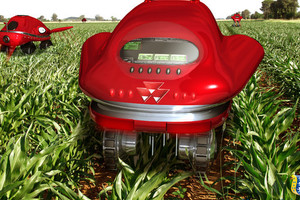
Companies are competing to turn data into advice on how to farm better, and attracting investments from the likes of Google Ventures and Monsanto.
Keith Larrabee’s farm sits on 4,000 acres of California’s Sacramento Valley, between a coastal range of mountains to the west and the tall Sierra Nevadas to the east. It’s an area that traditionally gets much more rain than most of the drought-stricken state. Even so, Larrabee is always worried about the cost and availability of water for his orchards of walnuts and pecans and his 3,000 acres of rice.
Two years ago he began inserting probes five feet deep into the soil of his nut orchards to measure the water concentration foot by foot.
When Larrabee began using such sensors, he had to walk into the fields to read each one individually—a process so laborious that he sometimes did it just once a week. But now, every 15 minutes, readings from the 25 sensors are fed into a network of solar-powered information-gathering stations scattered through the orchard. One of the stations transmits that information to a main database via cell signal. Larrabee uses his smartphone or tablet to log on to see that data, which is available almost instantaneously. Using a software platform called PTC
